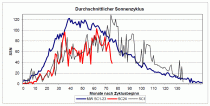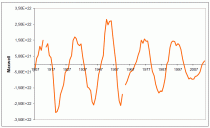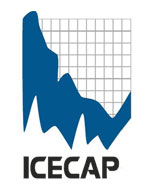The Global Warming Policy Foundation has enlisted an international team of five distinguished scientists to carry out a full inquiry
Last month, we are told, the world enjoyed “its hottest March since records began in 1880”. This year, according to “US government scientists”, already bids to outrank 2014 as “the hottest ever”. The figures from the US National Oceanic and Atmospheric Administration (NOAA) were based, like all the other three official surface temperature records on which the world’s scientists and politicians rely, on data compiled from a network of weather stations by NOAA’s Global Historical Climate Network (GHCN).
But here there is a puzzle. These temperature records are not the only ones with official status. The other two, Remote Sensing Systems (RSS) and the University of Alabama (UAH), are based on a quite different method of measuring temperature data, by satellites. And these, as they have increasingly done in recent years, give a strikingly different picture. Neither shows last month as anything like the hottest March on record, any more than they showed 2014 as “the hottest year ever”.

An adjusted graph from the Goddard Institute for Space Studies Enlarged
Back in January and February, two items in this column attracted more than 42,000 comments to the Telegraph website from all over the world. The provocative headings given to them were “Climategate the sequel: how we are still being tricked by flawed data on global warming” and “The fiddling with temperature data is the biggest scientific scandal”.
My cue for those pieces was the evidence multiplying from across the world that something very odd has been going on with those official surface temperature records, all of which ultimately rely on data compiled by NOAA’s GHCN. Careful analysts have come up with hundreds of examples of how the original data recorded by 3,000-odd weather stations has been “adjusted”, to exaggerate the degree to which the Earth has actually been warming. Figures from earlier decades have repeatedly been adjusted downwards and more recent data adjusted upwards, to show the Earth having warmed much more dramatically than the original data justified.
So strong is the evidence that all this calls for proper investigation that my articles have now brought a heavyweight response. The Global Warming Policy Foundation (GWPF) has enlisted an international team of five distinguished scientists to carry out a full inquiry into just how far these manipulations of the data may have distorted our picture of what is really happening to global temperatures.
The panel is chaired by Terence Kealey, until recently vice-chancellor of the University of Buckingham. His team, all respected experts in their field with many peer-reviewed papers to their name, includes Dr Peter Chylek, a physicist from the National Los Alamos Laboratory; Richard McNider, an emeritus professor who founded the Atmospheric Sciences Programme at the University of Alabama; Professor Roman Mureika from Canada, an expert in identifying errors in statistical methodology; Professor Roger Pielke Sr, a noted climatologist from the University of Colorado, and Professor William van Wijngaarden, a physicist whose many papers on climatology have included studies in the use of “homogenisation” in data records.
Their inquiry’s central aim will be to establish a comprehensive view of just how far the original data has been “adjusted” by the three main surface records: those published by the Goddard Institute for Space Studies (Giss), the US National Climate Data Center and Hadcrut, that compiled by the East Anglia Climatic Research Unit (Cru), in conjunction with the UK Met Office’s Hadley Centre for Climate Prediction. All of them are run by committed believers in man-made global warming.
Below, the raw data in graph form
For this the GWPF panel is initially inviting input from all those analysts across the world who have already shown their expertise in comparing the originally recorded data with that finally published. In particular, they will be wanting to establish a full and accurate picture of just how much of the published record has been adjusted in a way which gives the impression that temperatures have been rising faster and further than was indicated by the raw measured data.
Already studies based on the US, Australia, New Zealand, the Arctic and South America have suggested that this is far too often the case.
But only when the full picture is in will it be possible to see just how far the scare over global warming has been driven by manipulation of figures accepted as reliable by the politicians who shape our energy policy, and much else besides. If the panel’s findings eventually confirm what we have seen so far, this really will be the “smoking gun”, in a scandal the scale and significance of which for all of us can scarcely be exaggerated.
More details of the Global Warming Policy Foundation’s International Temperature Data Review Project are available on the inquiry panel’s website.
---------
Solar Cycle 24 Continues To Be Quietest In Almost 200 Years...Sun’s Polar Fields Weakest Since 1900 -
By P Gosselin on 12. April 2015
Although over the last 2 years the current solar cycle saw some activity, it recently has quieted down considerably and it continues on the path to being one of the quietest since observations began over 350 years ago. PG
-------
The Sun In March 2015
By Frank Bosse and Fritz Vahrenholt
Translated, edited by P Gosselin
Last month our sun gave a really sluggish impression. The sunspot number (SSN) was only 38.4: only 46% of what is normal at this time into a cycle for all the cycles observed since 1750.

Fig. 1: The current solar cycle 24 compared to the mean of all previous cycles (blue) and to solar cycle no. 1, 1755-1766, (black).Enlarged
Comparing the individual cycles to each other further confirms that the current cycle is a quiet one compared to those we saw in the second half of the last century:
_thumb.gif)
Fig. 2: Comparison of all the solar cycles. The figures represent the summed SSN deviation from the mean for first 76 months into the cycle, for all cycles. The current cycle so far is the 4th most inactive since observations began in 1750. Enlarged
The current cycle is the quietest since solar cycle no. 7, which occurred around 1830. When it comes to the question of why, the polar magnetic fields of the sun are decisive. We reported on this in detail (see “The sun in Jaunary 2014 and news about the polar solar field"). Its been a few months since the last data recording and today we are 2 years past the suspected smoothed maximum. The polar fields went through the zero-point already in March 2013, as can be seen from the data from the Wilcox Solar Observatory (WSO). There it can be seen that especially the north polar field is still barely established.
How does that compare historically?
Recording of data for the polar fields first began in the early 1970s, which means the time period is still too short to allow real comparisons to be made. But in a paper from 2012 the authors led by Andres Munoz-Jaramillo used the observations of solar flares made since 1900 as a proxy for the sun’s polar fields. The lead author of the paper kindly agreed to share the data with the authors of this article and so it is possible to compare the current relationships with the long-term series:

Fig. 3: The relative strength of polar solar fields since 1900. Enlarged
Here it is clear to see that in the second year past the cycle peak, the polar fields have never been so weak. Consider that the strength of the sun’s polar fields during the solar sunspot minimum is a decisive indicator for the activity of the next solar cycle. A very recent paper by Robert Cameron and Manfred Schussler confirms this.
We only need to be patient a little longer and to pay further attention to the ongoing development of the sun’s polar fields in order to attempt a forecast. The preliminary indications do point to a low level of activity and thus perhaps an even weaker solar cycle 25 beginning around 2022.
Better for states not to comply with the EPA’s plans than to go along and absolve the feds of accountability for the mess.
By Kenneth C. Hill
April 21, 2015 7:33 p.m. ET
Senate Majority Leader Mitch McConnell (R., Ky.) set off a firestorm recently when he advised states not to comply with the Environmental Protection Agency’s Clean Power Plan. Yet that advice isn’t as radical as his detractors make it sound. As a state public utilities commissioner who deals with the effects of federal regulations on a regular basis, I also recommend that states not comply.
Proposed last summer and with a final rule due in June, the Clean Power Plan aims to reduce overall U.S. carbon-dioxide emissions by 30% from 2005 levels by 2030. Each state must cut its emissions by a different amount, ranging from an 11% reduction in North Dakota to 72% in Washington, using a baseline established by the EPA.
From the EPA’s perspective, states have two options for achieving these reductions. The agency’s preferred option is for states to comply and create their own State Implementation Plans, or SIPs, which would allow the feds to share the blame for the ensuing electricity-rate increases and destabilized energy grid.
The other option, which Sen. McConnell and I support, is refusal to comply, at which point the EPA would impose a Federal Implementation Plan that risks even greater harm. The EPA designed this threat to force state lawmakers into compliance. But while letting the feds call the shots may seem risky, it will force them to own the individual implementation plans and the overall regulation. This also places the feds in a legally tenuous position that is fraught with political repercussions.
States choosing to comply with the regulation have until next summer to submit their SIPs. They can achieve emissions reductions through four “building blocks” - reducing coal use, increasing natural-gas use, using more renewable and nuclear energy, and enhancing energy-efficiency standards.
No matter which building blocks the states use, electricity rates are expected to soar. According to a recent study by NERA Economic Consulting, electricity costs will increase by as much as $366 billion between 2017 and 2031, with 43 states seeing double-digit rate increases each year. Coal-dependent states like Utah, Wyoming and Montana will see their rates increase the most - an estimated 20%, 18% and 16%, respectively, each year. Less coal-dependent states will likely see their rates increase by around 10%.
Moreover, in a 2014 report the North American Electric Reliability Corp. warned of threats to the stability of the U.S. energy grid as the regulation moves toward full implementation in 2030. “Constructing the resource additions, as well as the expected transmission enhancements,” NERC said, “may represent a significant reliability challenge given the constrained time period for implementation.”
Any state that doesn’t comply will be assigned a federal plan. But the problem for the EPA is that the federal government lacks the legal authority under either the Constitution or the Clean Air Act to enforce most of the regulation’s “building blocks” without states’ acquiescence. This severely limits the EPA’s ability to tailor a federal plan to a state’s unique needs.
Any federal plan will likely rely heavily on building block No. 1 - reducing coal usage - which will require draconian cuts to the number of coal-reliant power plants in noncompliant states. The likely result will be even greater electricity-rate increases than if states were to draft their own plans.
Proponents of the Clean Power Plan therefore argue that any state lawmakers who oppose the regulation - not the EPA that created it - will be responsible for higher energy costs. As such, they argue, states opposed to the EPA’s demands should comply with the regulation to prevent even greater harm.
This argument should be dismissed out of hand. While the short-term effects may be painful, the long-term consequences of submitting to this federal power grab are far worse.
For one, compliant states will enter into a “Mother may I?” relationship with the federal government. Not only will the initial SIP require the EPA’s blessing, so will any future modifications. This gives the EPA de facto veto power over any proposed state energy regulations, thus centralizing all energy decisions in Washington.
Compliance also would absolve the federal government of accountability once the disasters of this regulation begin to unfold. The regulation is designed so states will share blame with the EPA when electricity rates skyrocket. If federal regulators want to raise Americans’ electricity bills by thousands of dollars each year, they can do that. State lawmakers would be wise to let them walk that road alone.
The more states that refuse to give in to the EPA’s demands, the more likely it is that the agency will be forced to hold back the most burdensome elements of its Clean Power Plan. This could mean anything from nonenforcement to amending provisions of the regulation to mitigate their impact.
All of this assumes the regulation will ultimately go into effect, which is far from certain. Thirteen states are challenging the plan in federal court as unconstitutional and in violation of the Clean Air Act. Such liberal legal scholars as Harvard Law Schoo’s Laurence Tribe have supported this position.
With the first SIPs not due until June 2016, state lawmakers still have plenty of time to weigh their options. As they do, they should understand the long-term implications of their final decision. Giving in to Washington’s demands might seem like the easy option now, but it will ultimately do far more harm in the long run.
Mr. Hill is a director of the Tennessee Regulatory Authority.
A recent public letter, “To the Museums of Science and Natural History,” demands that museums in the United States accept no charitable donations from companies involved with fossil fuels. The idea that the world can or should abandon fossil fuels is deeply wrong-headed, not just from a scientific perspective, but also from a humanitarian perspective.
For thousands of years only a small fraction of mankind lived well while the rest faced poverty, filth, hunger and disease. That has all changed over the past century and a half, thanks to the use of fossil fuels. The benefits of low-cost and abundant energy from fossil fuels have permitted a standard of living for most of society that exceeds the wildest dreams of past elites. Today China, India and other developing countries are lifting hundreds of millions of people out of deprivation by the greater use of fossil fuels. Despite these clear benefits, a movement has emerged that demonizes fossil fuels and anyone who questions the dogma that a near-term climate catastrophe is upon us. The letter is a good example of the movement’s tactics.
Nearly everyone today is instinctively an environmentalist. Most recognize that fossil fuels must be extracted responsibly, minimizing environmental damage from mining and drilling operations, and with due consideration of costs and benefits. Similarly, fossil fuels must be used responsibly, deploying technologies that minimize emissions of real pollutants such as fly ash, carbon monoxide, oxides of sulfur and nitrogen, heavy metals, and volatile organic compounds. If fully cleansed of such real pollutants, the exhaust from fossil-fuel combustion contains very nearly the same components, and in comparable proportions to those of a baby’s breath: a little oxygen, nitrogen, water vapor (H20) and carbon dioxide (CO2). So far the movement has not declared water vapor to be a pollutant, but for several decades it has mounted a vigorous, extensive and expensive propaganda campaign to demonize CO2.
Atmospheric CO2 is beneficial and it is not a pollutant. It is, in fact, the most important food for life on Earth. Without CO2 in the atmosphere our planet would be as dead as Mars. At current CO2 levels of about 400 parts per million, the Earth remains in a CO2 famine compared to levels of 1000 parts per million and higher that have prevailed since the Cambrian period, some 550 million years ago. The world has already shown noticeable “greening” because plants are growing better and more extensively due to the modest increases of atmospheric CO2 seen over the past century.
However, the movement has promoted a multitude of scary scenarios associated with CO2, none of which have come to pass. Why doesn’t the letter contain the earlier favored phrase, “global warming?” Most likely because precise satellite measurements have shown there has been no global warming of Earth’s atmosphere for nearly 20 years, in stark contrast to the alarming predictions of the movement and deeply flawed computer models, most of which do not predict catastrophe anyway.
Instead of arguments based on science and facts, the movement labels any who question their dogma as “deniers,” funded, according to the letter, by “climate-change-denying organizations spending over $67 million since 1997 to fund groups denying climate change science.” The hypocrisy is breathtaking. Orders of magnitude more funding has been given by governments and foundations to organizations and individuals charged with “scientifically” proving the alleged evils of CO2 and inventing ways to cope with it. In 2011 alone, ten large foundations donated $577 million to environmental causes, nearly ten times more than the total funding since 1997 to the so-called “deniers.” And that does not count tens of billions of dollars from the government and other foundations. Apparently the movement’s scientific case is so weak that they feel threatened by any research that does not support their doctrine.
We applaud support for informative studies of the climate, for example, ocean monitoring programs, satellite instruments, or meteorological networks with high-quality data archives. This work needs no defense from scientific challenges, regardless of the source of funding. The honest scientists responsible for much of this excellent work cannot be blamed for the excesses of the anti-fossil fuel movement. But the signers of the letter include some of the biggest feeders at the climate trough, who benefit from millions of dollars of funding every year for research empires, which, in many cases, stoke a propaganda mill instead of producing real science. In the interests of transparency and intellectual integrity, the signatories of the “To the Museums” letter should have each revealed their annual and cumulative climate funding.
The criterion for valid science has been succinctly stated by physics Nobel Laureate, Richard Feynman: “If it disagrees with experiment, it’s wrong. In that simple statement is the key to science. It doesn’t make a difference how beautiful your guess is, it doesn’t make a difference how smart you are, who made the guess or what his name is, if it disagrees with experiment it;s wrong.” Experiments-observations-do not support the movement’s alarming scenarios.
We, the undersigned, urge museum managements to reject the exceptionally bad and misguided advice in the letter. Abandoning fossil fuels, aside from the economic impossibility of that proposition, would not help the environment but would likely harm it, and would be profoundly anti-human and immoral. Without the benefits of low-cost and abundant energy from fossil fuels, much of the world’s poor today and in the future would be condemned to continued poverty, ignorance and exploitation.
SIGNATORIES
Click here to view a pdf file of the signatories of this letter.
TO ADD YOUR NAME
We welcome additional signers, both US and non-US citizens, who are informed about CO2 and climate. If you would like to add your name, please send an email to climatesigners@gmail.com. Include your name and a short affiliation, analogous to that of other signers. Also include a brief paragraph to show that you are familiar with the facts of climate and CO2, either as a scientist, a meteorologist, an engineer, or an informed person with another occupation. We will review this paragraph and add your name to the list if we judge that you base your opinions on knowledge. Neither information from this paragraph, nor your e-mail address, will be made public.



